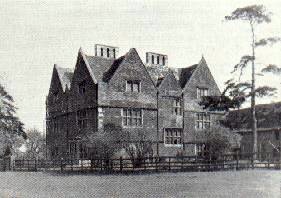|
Past owners
of the
Red Hall |
 |
|
1605 |
Probably built by Gilbert Fisher, a London grocer, as a
family home, although if he was not the original inspiration for the
house, he was the first tenant. He died in 1633 seriously in debt
and the house subsequently passed to his son, William Fisher,
and then his grandson, also Gilbert Fisher. |
|
1698 |
Gilbert Fisher made the house over to trustees
because he too was in debt and they sold it to Richard Dixon,
described in his will as a yeoman but in the purchase deed as an inn
holder (1703). The document also states that he bought the Red Hall
and 60 acres of land from Gilbert Fisher, grocer, of London, and a
small group of persons of whom three were his creditors. Attached to
the document are two lists, one of 15 names of persons to whom
Gilbert owed sums of money totalling £438 16s. 4d. Three of these
creditors, Thomas Tatlock, Francis Smith and Allen Hackshaw, are
described as grocers, of London. The other list of 62 names owing a
total of £262 15s. 7¼d. to Gilbert
include some named grocers, and other persons, sometimes with their
addresses, such as Mrs Ann Briggs, of East Smithfield, Mr Piggott, a
chandler, of Broad Street, Mr Acres, a Jew, of Dukes Place, Captain
Carter, of His Majesty's ship the Blackwall, Mrs Partridge, the
coffee house, in Leadenhall Street, Mr Gibson, linen draper, and Mr
Parrott, hatter, also Leadenhall Street, and others mainly in or
near London, but including Mr Bateman, of Nottingham. |
|
1721 |
Left by Richard Dixon in his will to his wife
Barbara, together with two water mills in Eastgate and Westgate, and
other properties together with 66 acres of
arable meadow and pasture land, to help settle his debts totalling
£438 16s 4d.to various tradesmen including grocers, a hatter, a
draper and others. |
|
1723 |
Sold by Barbara Dixon, widow of Richard Dixon, to Richard Warwick, of Stamford, together
with 30 acres of land around the Red Hall and a further 50 acres in
the fields of Bourne, who used a mortgage to secure the purchase
price of £850. |
|
1730 |
John Digby (1707-51) became the owner through his
marriage to Elizabeth, daughter and heir of Richard Warwick. |
|
1777 |
James Digby inherited the Red Hall on the death
of his father. In 1796, he married Catherine, daughter and heiress
of the Rev Humphrey Hyde, Vicar of Bourne. |
|
1811 |
Catherine Digby inherited the Red Hall for life
on the death of her husband. |
|
1836 |
When Catherine died, under the terms of her late
husband's will, ownership of the Red Hall passed to his younger sister, Henrietta Pauncefort,
who leased the property to various tenants. |
|
1841 |
The Red Hall was leased to Charles Sleith Esq who
described it as his country seat. |
|
1842-43 |
The Red Hall and farmland were leased to Peter
Nicol, junior. |
|
1847 |
The Red Hall was leased to Captain Peacock of
Timberland, Lincolnshire. |
|
1849 |
When Mrs Pauncefort died, ownership passed to her
nephew, Philip Pauncefort Duncomb and
then on his death, to his son, also Philip. During this period, the
Red Hall continued to be leased to various tenants. |
|
1849-61 |
The Red Hall was used as a private boarding
school for young ladies under the direction of Mrs Elizabeth West
(1849), Miss Elizabeth Sardeson (1851) and Miss Elizabeth Wood
(1856). |
|
Public notice from the Stamford
Mercury on Friday 13th July 1849 |
 |
|
|
1860 |
The Red Hall, together with adjoining buildings
and five acres of land, was sold by Philip Pauncefort Duncomb to the
Bourne and Essendine Railway Company for £1,305 for use as the new
railway station booking office and stationmaster's house. |
|
1959 |
The Red Hall became redundant when the railway
line closed and was offered for sale for £1 to the various
local authorities but all refused and suggested that it was "a useless
building" that should be demolished. |
|
1962 |
The last tenant of the Red Hall was Charles Cator,
a tailor, who rented his living and workshop accommodation on the
north side of the building from the railway company. He and his wife
lived there for thirty years and they finally moved out when the
property changed hands. |
|
1962 |
The freehold of the Red Hall was acquired by
Bourne United Charities. |
|
1972 |
After a major restoration programme, the Red Hall
was re-opened as a community centre, museum and offices for Bourne United
Charities and remains in use to this day. It is now Grade II listed. |
NOTE: The title deeds and other documents relating to
the Red Hall and various
conveyances are now held by Lincolnshire County Archives.
Return to The Red Hall

Go to:
Main Index Villages
Index
|